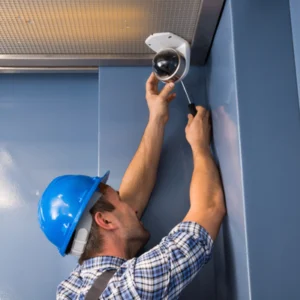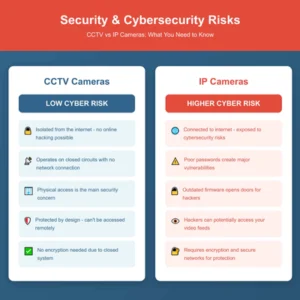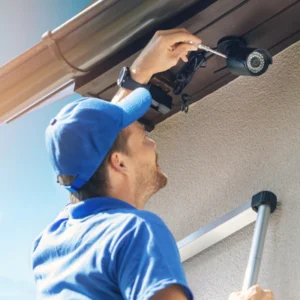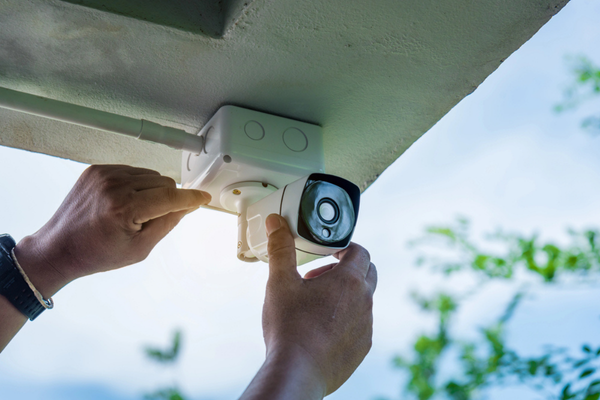Choosing the right security camera system can feel overwhelming. You want to protect your property without breaking the bank or dealing with complex installation. The two main options are IP cameras and traditional CCTV cameras. Each has unique features, costs, and benefits.
This guide breaks down the key differences. You’ll learn about picture quality, storage options, and network infrastructure requirements, and by the end, you’ll know which system best meets your security demands and budget.
Understanding the Core Differences

IP cameras work differently. These network cameras send digital data over Ethernet cables or wireless connectivity. The Internet Protocol allows them to connect to your existing network. IP cameras can stream video feeds to a network video recorder or cloud storage.
The biggest difference is how they handle data transmission. CCTV cameras use analog signals while IP cameras use digital signals. This affects everything from video quality to remote access capabilities.
Video Quality and Image Resolution
IP cameras provide greater image quality. Most current IP cameras have high-resolution options such as 1080p, 4K, and higher. Digital formats keep detail better than analog systems.
CCTV cameras typically max out at lower camera resolutions. Standard analog systems struggle to capture fine details. However, newer models have improved image quality in recent years.
Resolution matters when you need to identify faces or license plates. IP cameras provide clearer images for security applications. Better frame rate options also mean smoother video during fast motion. The advanced compression technology in IP cameras helps manage file sizes without losing image quality.
Installation and Setup Requirements
CCTV camera installation is straightforward. Each camera is connected to the DVR via a coax connection. The system operates independently of a network connection, and most people can complete the basic setup without expert assistance.
IP camera installation necessitates network infrastructure and sufficient capacity to accommodate multiple video streams. POE (Power over Ethernet) streamlines installation by sending power and data via a single wire. Some versions have power options, such as standard plugs or battery backup.
Cabling requirements vary between systems. CCTV cameras require separate coax cable lines to each camera. IP cameras can connect wirelessly or over existing Ethernet lines. This flexibility frequently reduces installation time and expense.
Storage and Recording Options
CCTV camera systems store footage on a local DVR. The storage capacity depends on the hard drive size. You can typically record several weeks of footage before overwriting old files.
IP cameras offer more storage choices. A network video recorder works like a DVR but handles digital streams. Cloud storage provides off-site backup and cloud remote access from anywhere. Some IP cameras include built-in storage cards for backup recording.
Storage needs depend on camera count and recording settings. Motion detection helps reduce storage use by only recording when activity occurs. Video analytics can tag important events for easy searching. The recording management functions in IP camera systems give you more control over what gets saved.
Remote Access and Monitoring Capabilities

CCTV camera systems traditionally lack remote capabilities. You need to be at the DVR location to view footage. Some newer DVR systems add network features, but they’re limited compared to IP solutions.
IP cameras let you check your property while traveling. You can receive motion detection alerts and review clips instantly. Remote access provides peace of mind while you’re away. This flexibility is valuable for business owners and homeowners who want constant video surveillance awareness.
Cost Comparison and Budget Planning
CCTV cameras cost less upfront, and basic analog cameras run cheap per unit. The DVR and coax cable add minimal expense, so the total costs of a small system are under budget for most people.
IP cameras have higher initial costs, and better image quality and features come at a premium. You may need network infrastructure upgrades. However, expandability and scalability make long-term costs competitive.
Consider maintenance expenses too. CCTV cameras need occasional DVR replacement and cable repairs. IP cameras require network maintenance and software updates. Cloud storage adds monthly subscription costs. Calculate total ownership costs over five years for accurate comparison.
Bandwidth and Network Performance
IP cameras take a substantial amount of bandwidth. A single 1080p camera consistently consumes 2-4 Mbps. Multiple IP cameras might overload residential internet connections. Remote viewing requires a decent upload speed.
CCTV cameras do not degrade network performance. They use closed circuits that are independent of your internet connection. This benefit is important in places with poor connectivity.
Before selecting IP cameras, make sure your network has enough capacity. Upgrading your router or internet subscription may be required. Local recording saves bandwidth by eliminating frequent cloud uploads. Consider the network infrastructure needs when making your decision.
Security and Cybersecurity Risks

IP cameras pose a cybersecurity concern. Poor passwords and out-of-date firmware create risks. If your video feeds are not properly encrypted, hackers may be able to view them. Strong encryption and secure networks greatly mitigate these threats.
Secure IP cameras with strong passwords and frequent maintenance upgrades. Set up separate networks for cameras and personal devices. Turn on two-factor authentication when it is available. These measures reduce security vulnerabilities while retaining video surveillance benefits.
Scalability and System Expansion
Adding cameras to systems has different limits. DVR capacity restricts camera count in traditional setups. Running new coax cable for each camera takes time and effort. The expandability depends on your existing configuration.
IP cameras offer better scalability. Add cameras by connecting them to your network infrastructure. No new cables needed if using wireless options. Network switches extend capacity easily. This flexibility helps businesses grow their security camera system over time.
Consider future needs when choosing. Will you add more cameras later? IP camera systems adapt more easily to expansion plans. The surveillance technology continues to improve with software updates and integration options.
Advanced Features and Functionality
IP cameras pack more features than traditional options. Video analytics detect specific events like loitering or crowd formation. Night vision using infrared improves low-light performance. Two-way audio lets you communicate through cameras. Software functionality expands through regular updates.
Basic monitoring is what you get with traditional systems. Motion detection is standard but limited in older models. Advanced features require specialized equipment and higher costs. The surveillance industry has recently focused its development on digital technology.
Smart integration connects IP cameras with other systems. Link them to alarms, access control, or automation. This integration creates comprehensive security solutions for modern needs. Traditional options lack these capabilities entirely.
Making Your Decision

Pick IP cameras for advanced features and flexibility. The superior resolution helps identify threats clearly. Remote access provides peace of mind from anywhere you go. Businesses planning growth need the scalability that modern security camera systems offer.
Your choice depends on specific needs and resources. Budget matters, but so does long-term value and maintenance requirements. Consider your technical comfort level with network equipment and installation challenges. Think about whether remote monitoring is essential for your situation.
Ready to upgrade your security? Assess your property’s weak points and coverage needs today. Calculate your total budget, including installation and maintenance costs, over five years. Research specific camera models that match your requirements and compression standards. Then contact a security professional for a custom quote and installation plan that protects what matters most.
Frequently Asked Questions
Can I mix IP cameras and CCTV cameras in one system?
Mixing both types is possible but complicated. You need separate recording systems for each camera type. Some hybrid DVR systems accept both analog and IP inputs. This adds cost and complexity to your security camera system setup.
Do IP cameras work without internet?
Yes, IP cameras function on local networks without internet connectivity. They can record to storage devices or built-in cards. You lose remote access and cloud features without connectivity. The cameras still capture footage for local playback and monitoring needs.
How much bandwidth do I need for IP cameras?
Each camera needs 2-6 Mbps, depending on resolution and compression settings. A four-camera system requires 10-25 Mbps upload speed for smooth remote access. Local recording reduces bandwidth needs significantly by avoiding constant uploads. Check your internet speed before installation to avoid performance issues.
Are CCTV cameras becoming obsolete?
CCTV cameras remain useful for specific security applications today. Many businesses still use them successfully for basic monitoring. The surveillance industry is moving toward IP technology for better image quality. However, analog systems will stay relevant where simplicity and costs matter most.

